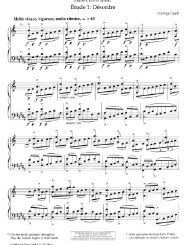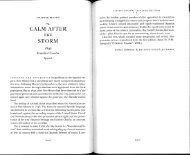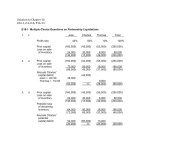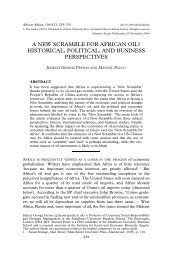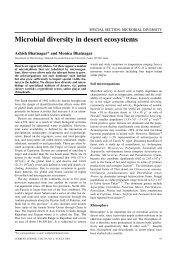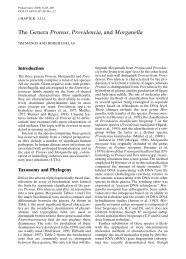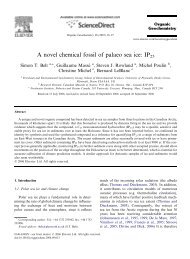Analysis by Key: Another Look at Modulation
Analysis by Key: Another Look at Modulation
Analysis by Key: Another Look at Modulation
You also want an ePaper? Increase the reach of your titles
YUMPU automatically turns print PDFs into web optimized ePapers that Google loves.
13i3SS<br />
ANALYSIS BY KEY<br />
Example 13 shows how the prolonged F chord of Ex. 12 is continued. If we<br />
think of the large bass motion F - (AW ) - C as an unfolded fifth, the D th<strong>at</strong><br />
follows the C would represent a sixth. Th<strong>at</strong> D, in turn, leads to the G minor <strong>by</strong><br />
the motion of a descending fifth. To sum up, the bass line th<strong>at</strong> spans the f1rst<br />
two of this section's three inner groupings constitutes the unfolding or<br />
horizontaliz<strong>at</strong>ion of the contrapuntal progression 5-6-5 (F-C, F-D, G-D).<br />
Ex. 13 Mozart: Le Nozze di Figaro, Act II, 'Voi che sapete', bs 35-52<br />
(g)(R @ ? '<br />
b > S_f S 5-h S<br />
Ap 4Hl ' ,-?<br />
r s 1l - 1 ; j ; ccomC > X j ; becOmes n<br />
l-'9P:rEf's6b:-')> r C rtv f>>t<br />
[llltOl(lillZ P ( [) (,<br />
After the G minor cadence, the vocal line moves to its clax on eS2,<br />
intensified <strong>by</strong> a doubling <strong>at</strong> the higher octave in the flute (bs 58-9). There is an<br />
apparent discrepancy between the melody and the harmony here. The melody<br />
note has a higher syntactic value than the brief C minor chord th<strong>at</strong> supports it;<br />
eS 2 prepares the seventh over the prolonged V shown in Ex. 11, whereas the C<br />
minor has no such large-scale function. This syntactic value is reflected in the<br />
sonic emphasis Mozart accords the eW 2 as the event th<strong>at</strong> caps an extended phase<br />
of increasinf intensity. Functioning within a larger context (from b.52), the<br />
climactic eS rel<strong>at</strong>es obliquely to the last high-level bass note, the G of b. 52; the<br />
reappearance of G in b.58 helps to clarify this connection. Since the vocal line in<br />
these bars unfolds a fourth bS l eS 2, the passage as a whole projects an ES sixth<br />
chord (G in bass, Bb and ES in soprano). Understood this way, bs 52-8 continue<br />
the earlier 5-6-5 altern<strong>at</strong>ion with another sixth, G-EW, an interval of the<br />
middleground not literally present on the surface but clearly plied <strong>by</strong> context<br />
(Ex. 14). In b.60, the G transfers from the bass into an upper part (oboe doubled<br />
<strong>by</strong> the violins), where it continues up to A and then on to BS in the reprise. The<br />
linear structure th<strong>at</strong> governs the plan of modul<strong>at</strong>ion is thus a rising fourthprogression<br />
rel<strong>at</strong>ed to those found in the Bach Allemande and Beethoven Son<strong>at</strong>a<br />
discussed earlier (Exs 9 and 10). In addition to the obvious differences in key<br />
succession, the Mozart also differs in th<strong>at</strong> the bass adds the root of V below the<br />
rising linear progression to allow a strong harmonic resolution into the reprise.<br />
Example 15 presents three middleground views of the B section. From it we<br />
can see how a repe<strong>at</strong>ed detail - the use of the enharmonic note-pair C,tt /DS<br />
MUSIC ANALYSIS 6: 3, 1987 311





